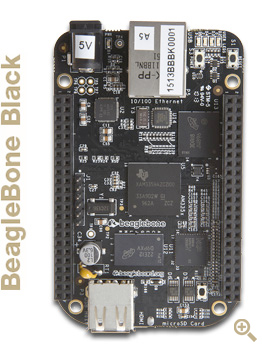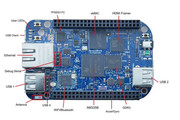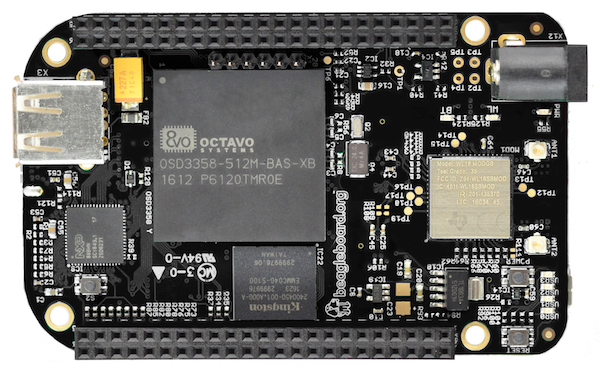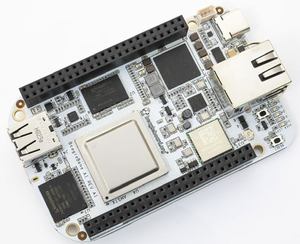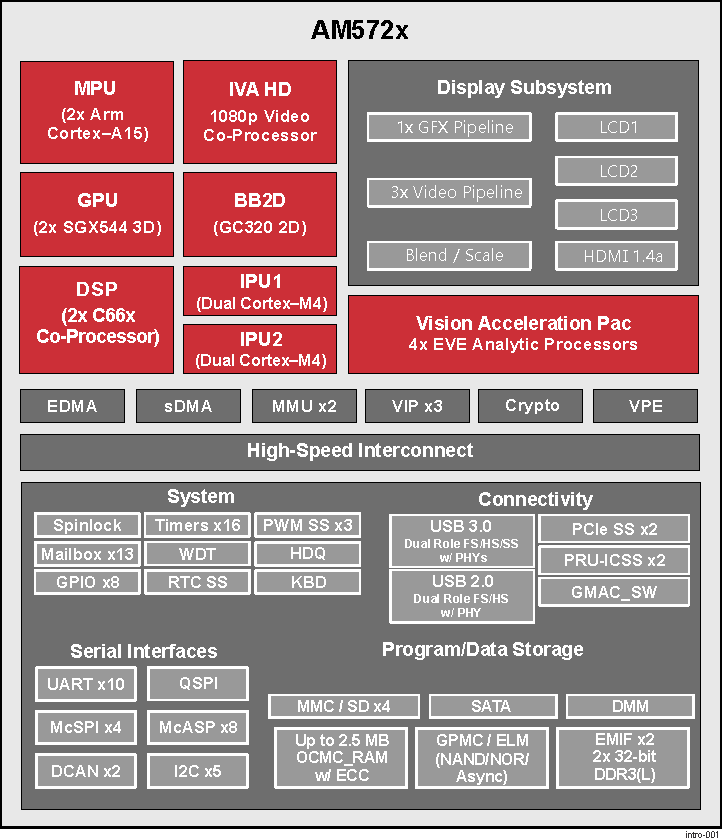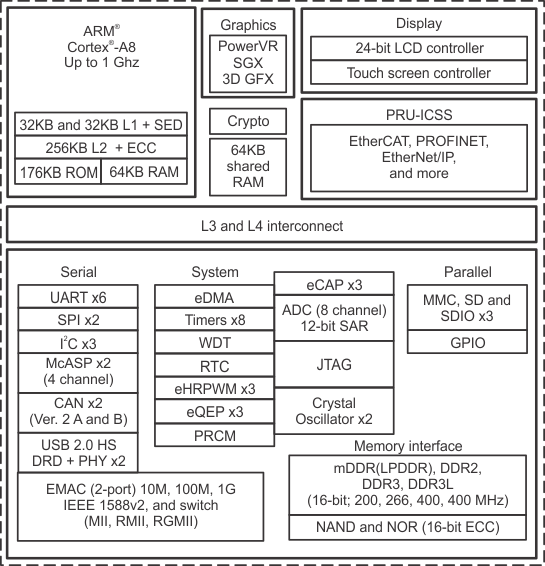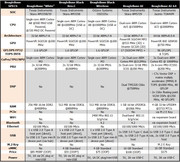Raspberry Pi Model B+
CPU : A Broadcom ARMv6-compatible processor ARM11, rev 7 (v6l), in short ARM1176JZF-S aka BCM2835
Features : swp, half, thumb, fastmult, VFP, edsp, java/jazelle, tls
- Raspberry Pi B+@700MHz (Stock speed)
222 floating point MIPS (Whetstone) per CPU
926 integer MIPS (Dhrystone) per CPU - Raspberry Pi B+@800MHz (Modest overclock)
266 floating point MIPS (Whetstone) per CPU
1073 integer MIPS (Dhrystone) per CPU - Raspberry Pi B+@950MHz (High overclock)
323 floating point MIPS (Whetstone) per CPU
1275 integer MIPS (Dhrystone) per CPU - Raspberry Pi B+@1000MHz (Turbo!)
338 floating point MIPS (Whetstone) per CPU
1355 integer MIPS (Dhrystone) per CPU
Beaglebone Black, Rev.C
CPU : A Texas Instruments ARMv7-A compatible processor ARM Cortex-A8, rev 2 (v7l) aka Sitara AM3358BZCZ100
Features : swp, half, thumb, fastmult, VFP, edsp, thumbEE, NEON, VFPv3, tls
- Beaglebone Black @1000MHz - Beagle Debian
184 floating point MIPS (Whetstone) per CPU
2047 integer MIPS (Dhrystone) per CPU - Beaglebone Black @1000MHz - Android 4.4.4
277 floating point MIPS (Whetstone) per CPU
1607 integer MIPS (Dhrystone) per CPU

ARM11, ARM Cortex-A8 and Cortex-A9 compared.
SIMD for the ARM11 seems a misconception, while the Beaglebone's Cortex-A8 actually reports VFPv3 instead of VFP Lite.
BTW: The Solid Run CuBox and the Solid Run Hummingboard have a Cortex-A9.
Me dual core hearties, one so far (Freescale i.MX6-based Hummingboard I2ex planned as Dutch importer won't sell quad core I4ex models):
Banana Pro
CPU : An Allwinner ARMv7-A compatible processor ARM Cortex-A7, rev 4 (v7l) aka Allwinner A20
Features : swp, half, thumb, fastmult, VFP, edsp, NEON, VFPv3, tls, VFPv4, idiva, idivt
- Banana Pro @1000MHz - Bananian
463 floating point MIPS (Whetstone) per CPU
1911 integer MIPS (Dhrystone) per CPU - Banana Pro @1000MHz - Ubuntu Mate
554 floating point MIPS (Whetstone) per CPU
1965 integer MIPS (Dhrystone) per CPU
Raspberry Pi 2, Model B
CPU : A Broadcom ARMv7-A compatible processor ARM Cortex-A7, rev 5 (v7l) aka BCM2836
Features : half, thumb, fastmult, VFP, edsp, NEON, VFPv3, tls, VFPv4, idiva, idivt, VFPd32, lpae, evtstrm
- Raspberry Pi 2@900MHz
441 floating point MIPS (Whetstone) per CPU
1704 integer MIPS (Dhrystone) per CPU - Raspberry Pi 2@1000MHz
491 floating point MIPS (Whetstone) per CPU
1895 integer MIPS (Dhrystone) per CPU
Much to my chagrin I could not obtain these values myself. Even when OC-ing to 1000 MHz I got stuck at 292 MIPS floating point MIPS (Whetstone) per CPU and 1143 integer MIPS (Dhrystone) per CPU: worse than the RasPi 1 at that speed! So I searched for an answer. It seemed that those froggies must have had installed Debian Jessie -but in 2013?- in order to get the NEON capabilities of the RasPi2....but installing Jessie got me no further than 293 MIPS floating point MIPS (Whetstone) per CPU and 1163 integer MIPS (Dhrystone) per CPU -and a more up-to-date BOINC client (7.4.23).
After a while my Raspi2 hickupped and refused to work. As my work as DHL courier took a forever greater part of my working days, I was unable to change this until one free evening. Through Synaptic I installed some extra armhf related files and see:
Raspberry Pi 2@1000MHz armhf updated
489 floating point MIPS (Whetstone) per CPU and
1448 integer MIPS (Dhrystone) per CPU!
Still not quite the values of our amphibious friends yet, but quite an improvement... 8)
Now to unlock the secrets of integer performance
Through Synaptic I installed some extra 'integer' related files and behold:
Raspberry Pi 2@1000MHz integer updated
489 floating point MIPS (Whetstone) per CPU
1944 integer MIPS (Dhrystone) per CPU


![[ TSBT's Pirate ] [ TSBT's Pirate ]](./images/ranks/British Army Ranks/Small Ranks/17_General.gif)




 ,
,
